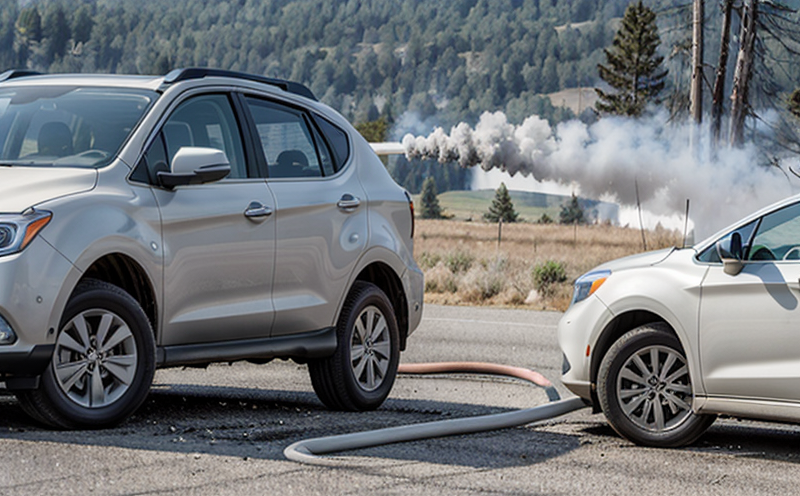Smoke and Gas Release Evaluation in Fire Scenarios
The evaluation of smoke density and toxic gas emissions during fire scenarios is critical to ensuring public safety and compliance with international standards. This service provides a comprehensive assessment of materials, products, and systems used in environments where fires are a potential risk. By understanding how these materials behave under fire conditions, we can improve the design and selection of fire-resistant and smoke-reducing products.
The process involves controlled laboratory testing to simulate real-world fire scenarios. The primary goal is to measure the amount of smoke produced by burning materials and the concentration of toxic gases released during combustion. This information is crucial for manufacturers and designers to ensure that their products meet regulatory requirements and contribute to safer environments.
Our approach begins with a thorough understanding of the material or product being tested. We consider its composition, form, and intended use in fire scenarios. Once this context is established, we proceed with the actual testing process, which involves several key steps:
- Specimen Preparation: The specimens are prepared according to specific standards (e.g., ISO 5636-2) ensuring they accurately represent the intended use in fire scenarios.
- Fire Simulation: Specimens are subjected to controlled fire conditions that mimic real-world scenarios. This allows us to observe and measure the smoke density, temperature rise, and gas emissions accurately.
- Data Collection: Various sensors and instruments are used to collect data on smoke density, temperature, and toxic gases like carbon monoxide (CO), carbon dioxide (CO2), hydrogen cyanide (HCN), and others. These measurements provide a clear picture of the material's performance under fire conditions.
- Data Analysis: The collected data is analyzed using advanced software tools to determine compliance with relevant standards and to identify areas for improvement.
The results are presented in detailed reports that include recommendations for enhancing the product or system. This service not only helps manufacturers comply with legal requirements but also enhances public safety by providing valuable insights into material performance during fires.
Our team of experts ensures that every aspect of the testing process is conducted according to international standards such as ISO, ASTM, and EN, ensuring reliability and accuracy in our findings.
Benefits
- Enhanced Safety: By evaluating smoke density and gas emissions during fire scenarios, we can identify materials that contribute to safer environments.
- Compliance Assurance: Our testing ensures compliance with international standards like ISO 5636-2 and EN 458, reducing the risk of legal issues.
- Improved Product Quality: The detailed reports provide valuable insights that can be used to enhance product performance and durability.
- Cost Efficiency: Early identification of potential issues during development stages saves costs associated with redesigning products later in the process.
The benefits extend beyond just compliance; they contribute to a safer built environment, reducing risk for both occupants and first responders. By leveraging this service, stakeholders can make informed decisions that enhance public safety and promote sustainable practices.
International Acceptance and Recognition
The testing of smoke density and toxic gas emissions during fire scenarios is recognized globally as an essential part of ensuring public safety. Our laboratory adheres to international standards, which are widely accepted across various countries. Compliance with these standards ensures that products meet the highest safety and quality benchmarks.
International acceptance of our test results enhances trust in the market, making it easier for manufacturers to export their products globally. By aligning with recognized standards such as ISO 5636-2 and EN 458, we ensure that our clients' products are not only safe but also competitive on a global scale.
The process of obtaining international recognition is rigorous and involves meeting stringent criteria set by regulatory bodies worldwide. Our team works closely with clients to navigate these processes effectively, ensuring that they can confidently present their results to international markets.
Environmental and Sustainability Contributions
Evaluating smoke density and toxic gas emissions during fire scenarios also plays a crucial role in promoting environmental sustainability. By understanding how materials behave under fire conditions, we can design products that are more environmentally friendly and reduce the risk of harmful emissions.
The results of our testing contribute to reducing the carbon footprint by identifying materials that minimize smoke and gas release during fires. This not only enhances public safety but also supports sustainable development goals. Our approach ensures that products are designed with both human health and environmental impact in mind, promoting a more sustainable built environment.
Furthermore, the insights gained from our testing can be used to develop new materials and systems that are inherently safer and more environmentally friendly. This contributes to the broader goal of creating a world where safety and sustainability go hand-in-hand.





